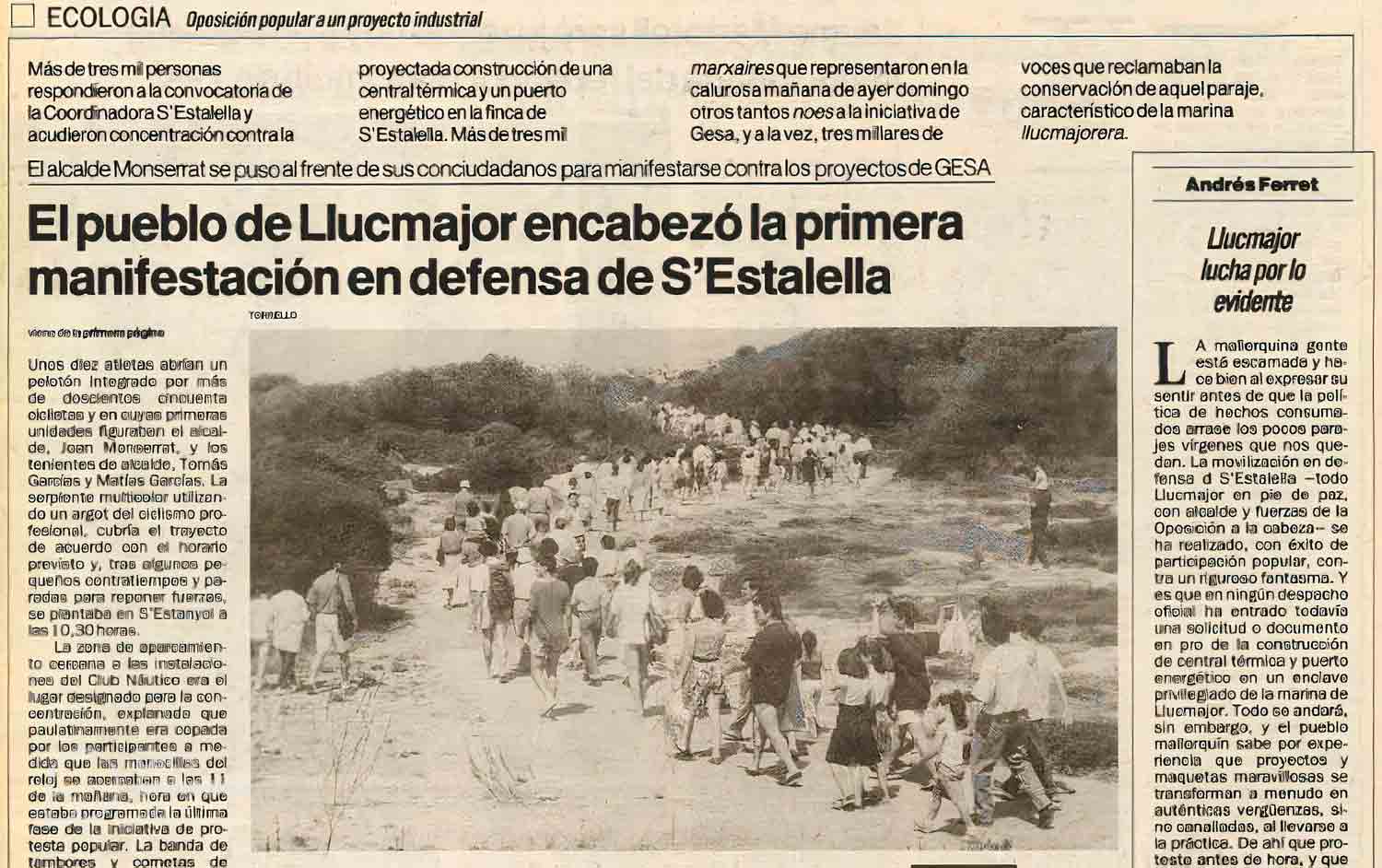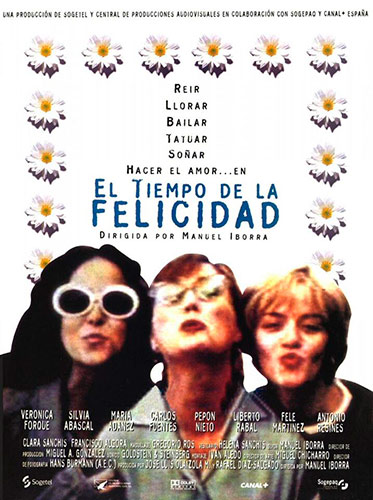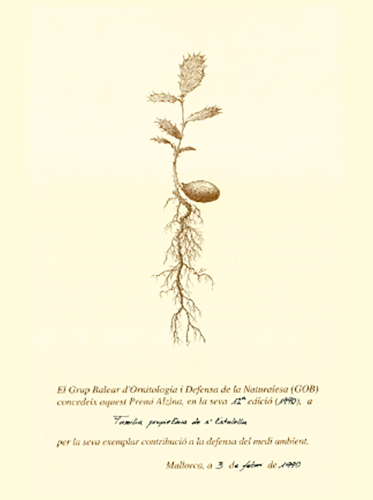Sa finca
The rural property of s’Estalella

The rural property of s’Estalella dates back to the XIII century, when the island of Majorca was conquered by King Jaume I and the consequent expulsion of Muslims happened. The first settler of the area was Ramón de Stella, and the rural property was subsequently passed down from generation to generation.
The following centuries were times of pirates and fishermen; it was then that a defence system that ran throughout the Majorcan coast with a hundred defence towers was devised. S’Estalella tower, dating from 1577, was the first one built. It was then that the fishermen settled in Punta de S’Estalella.
In early times, those lands were of little value due to the poverty of the farmland and the insecurity and destruction that privateer invasions caused.
The family owns S’Estalella since the eighteenth century and from the very beginning, its members have taken care of the environment in which the property is located. The implication was observed when the family decided to ratify the covenant that the previous owners had with the fishermen. The Fishing Village of Sa Punta de S’Estalella remained inhabited until the early twentieth century. Its abandonment was due to the construction of the neighbouring village of S’Estanyol de Migjorn. After a few years, the family decided to maintain and preserve those fishermen barrack huts already existing in the village and asked for the construction permissions in sea areas: the dry docks.
The early and mid-twentieth century was a time of smugglers, locals that in the face of the shortage of commodities undertook lucrative African adventures and used the southern coasts of Majorca to unload the goods they obtained.
During the early years of the tourist boom, s’Estalella was the object of desire of hoteliers, builders and other speculators. However, the family remained firm in order to protect the property and maintain its natural beauty. A well known example is the project of a power plant that the company GESA tried to carry out during the 70’s to 90’s. The project consisted of a coal power plant, a port for cargoes, an industrial area and a large residential community. Its achievement meant the total destruction of the natural environment in which s’Estalella is located. After many economic and political pressures, the family decided not to give in, and fought for the conservation and preservation of the environment. It is essential to underline the popular mobilization of the city of Llucmajor, as reflected in the 1990 mass demonstration held on the property.
There is a controversy in the etymology of s’Estalella. Catalan-Valencian-Balearic Dictionary attributes it to a “Estadella” or small room of what once was the path of the cheesemakers; it also mentions the possibility of deriving from “Estrella” (“star”), which is the shape that the coastline of the property draws into the sea. Moreover, various sources suggest that perhaps the name comes from Ramón Stella, first settler of this area and owner of the rural property in the thirteenth century.
The following centuries were times of pirates and fishermen; it was then that a defence system that ran throughout the Majorcan coast with a hundred defence towers was devised. S’Estalella tower, dating from 1577, was the first one built. It was then that the fishermen settled in Punta de S’Estalella.
In early times, those lands were of little value due to the poverty of the farmland and the insecurity and destruction that privateer invasions caused.
The family owns S’Estalella since the eighteenth century and from the very beginning, its members have taken care of the environment in which the property is located. The implication was observed when the family decided to ratify the covenant that the previous owners had with the fishermen. The Fishing Village of Sa Punta de S’Estalella remained inhabited until the early twentieth century. Its abandonment was due to the construction of the neighbouring village of S’Estanyol de Migjorn. After a few years, the family decided to maintain and preserve those fishermen barrack huts already existing in the village and asked for the construction permissions in sea areas: the dry docks.
The early and mid-twentieth century was a time of smugglers, locals that in the face of the shortage of commodities undertook lucrative African adventures and used the southern coasts of Majorca to unload the goods they obtained.
During the early years of the tourist boom, s’Estalella was the object of desire of hoteliers, builders and other speculators. However, the family remained firm in order to protect the property and maintain its natural beauty. A well known example is the project of a power plant that the company GESA tried to carry out during the 70’s to 90’s. The project consisted of a coal power plant, a port for cargoes, an industrial area and a large residential community. Its achievement meant the total destruction of the natural environment in which s’Estalella is located. After many economic and political pressures, the family decided not to give in, and fought for the conservation and preservation of the environment. It is essential to underline the popular mobilization of the city of Llucmajor, as reflected in the 1990 mass demonstration held on the property.
There is a controversy in the etymology of s’Estalella. Catalan-Valencian-Balearic Dictionary attributes it to a “Estadella” or small room of what once was the path of the cheesemakers; it also mentions the possibility of deriving from “Estrella” (“star”), which is the shape that the coastline of the property draws into the sea. Moreover, various sources suggest that perhaps the name comes from Ramón Stella, first settler of this area and owner of the rural property in the thirteenth century.
Tomeu Penya live – S’Estalella
The time of happiness

In 1996 the Spanish film The time of happines, from the Spanish director Manuel Iborra, was shot in the rural property of s’Estalella. Its cast included renowned actors like Antonio Resines, Verónica Forqué, Carlos Fuentes, Silvia Abascal or Pepón Nieto.
The film is set in hippie Ibiza and tells the story of a motley family during a summer in the 70’s.
The film is set in hippie Ibiza and tells the story of a motley family during a summer in the 70’s.
Alzina rewards

After two decades of struggle to protect the natural environment of the rural property of s’Estalella and avert the disaster of the coal power plant construction, in 1990 the GOB (Balearic Ornithology Group), the leading environmental group in the Balearics, awarded the “Alzina” prize to the owner family of S’Estalella for “their exemplary contribution in defending the environment.”
Scientific articles
1. Barracks
a- Calviño, C. y Clar J. “LThe barracks of Llucmajor, a popular architecture. Anthropology and ethnography of the rural area of Llucmajor” Palma: Consell de Mallorca. 1999.
b- Calviño, C. y Clar, J. “The barracks, rural constructions in the municipal term of Llucmajor (Majorca). A general vision”. Zahora. Revista de traducciones populares, núm. 38 (2003). Vol II: I National Congress on Rural Architecture Dry stone.
S'Estalella fishermen's village
Click here to read the article published in Wikipedia.
d- 6th April 2006 resolution of the Majorca Island Council (Balearic Islands), concerning the listing as “Asset of Cultural interest” of the fishing village of s’Estalella (S´Estanyol, Llucmajor), Majorca.
2. Geology
a– Servera, J. y Rodriguez-Perea, A. (1997): “Coastal geomorphology of s’Estalella. In Llucmajor area: studies and comments”, 1: 9-30.
b- Cuerda J. y Sacarès, J. “The Quaternary at the Migjorn of Majorca”. Palma: Ministry of Culture, Education and Esports. General of Culture. 1992.
3. Toponymy of s’Estalella
a- Aguiló C. “The toponymy of the coast of Llucmajor”. Catalan Studies Institute, 1996.
b- Gazetteer of the Major Toponomy of the Balearic Islands
c- XX Anthroponymy and Toponymy day (La Real, 2007). “Notes on the toponymy of the stone quarries of s’Estalella”.
Others
4- De Chaves Alemany, J. “Coastal fortifications of Majorca”, Palma of Majorca: Ed. 1986
5- Alcover, A.M.; Moll, F. de B. Dictionary català-valencià-balear. Palma de Mallorca: Moll, 1962.
6- Font Obrador, B. “Hystory of Llucmajor”. Vol II. Palma: Gráficas Miramar, 1974
7- Rosselló Verger, V.M. “Majorca, the South and the Southeast”. Palma: Cámara de Comercio de las Islas Baleares, 1964.
